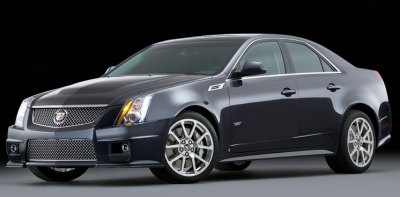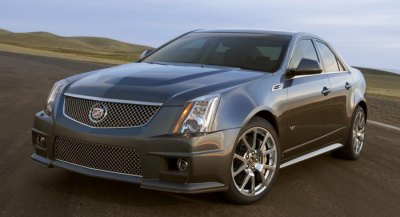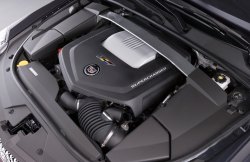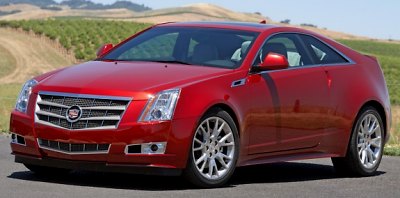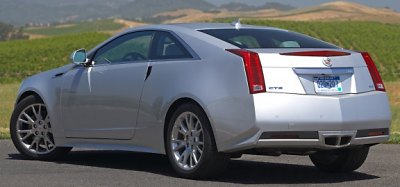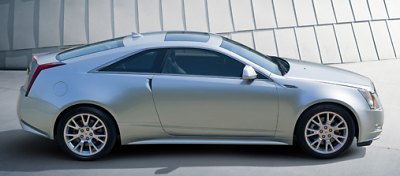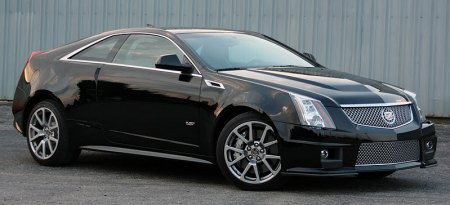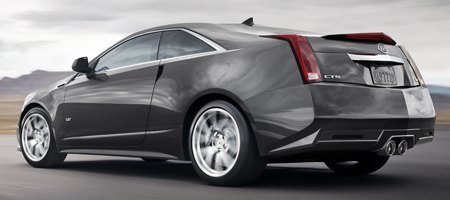Cadillac CTS
Debut: 2007 |
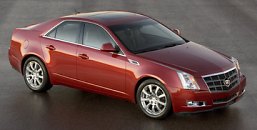 7 years since
its birth, Cadillac CTS has
entered the second generation. Although the outgoing CTS surprised us
by outstanding handling (thanks to the RWD platform and good
suspensions), it left a lot to be desired in build quality and
refinement. In particular, the interior felt too cheap to compete with
the likes of Audi A4 and BMW 3-series. In the remake, Cadillac lifted
its quality standard. This is easily visible from the completely
redesigned interior – now it is handsomely shaped, tightly assembled
and made of high-quality plastics, leather and aluminum, although the
design is more Japanese than European. Externally, you can see the
assembly gaps are narrow, paint finish seems perfect, while the restyle
on the "Art and Science" exterior design becomes smoother and has
better attention to details. It looks prettier than the old car as well
as the larger STS. 7 years since
its birth, Cadillac CTS has
entered the second generation. Although the outgoing CTS surprised us
by outstanding handling (thanks to the RWD platform and good
suspensions), it left a lot to be desired in build quality and
refinement. In particular, the interior felt too cheap to compete with
the likes of Audi A4 and BMW 3-series. In the remake, Cadillac lifted
its quality standard. This is easily visible from the completely
redesigned interior – now it is handsomely shaped, tightly assembled
and made of high-quality plastics, leather and aluminum, although the
design is more Japanese than European. Externally, you can see the
assembly gaps are narrow, paint finish seems perfect, while the restyle
on the "Art and Science" exterior design becomes smoother and has
better attention to details. It looks prettier than the old car as well
as the larger STS. To
deliver a perception of high quality, Bob Lutz asked his engineers to
install triple door seals to insulate wind and road noise more
effectively while producing the "thunk" of European cars. Ventilated
and heated seats, classy audio system and infotainment system lifts its
premium image right up to the level of Mercedes-Benz. The wider cabin
offers more shoulder room. The seatbacks are made thinner in order to
free up a couple more inches of rear legroom. To
deliver a perception of high quality, Bob Lutz asked his engineers to
install triple door seals to insulate wind and road noise more
effectively while producing the "thunk" of European cars. Ventilated
and heated seats, classy audio system and infotainment system lifts its
premium image right up to the level of Mercedes-Benz. The wider cabin
offers more shoulder room. The seatbacks are made thinner in order to
free up a couple more inches of rear legroom. Dimension-wise, the new CTS changes little from the old one. It retains the already long 2880mm wheelbase. Overall length is 4766mm (-64mm from the old car), overall width is 1841mm (+46mm) and overall height is 1472mm (+32mm). The tracks are widened by 50mm. Basically, most of the chassis structural parts come from the larger STS as both are built on the Sigma II platform. Suspensions continues to be double-wishbone up front but the wishbones and knuckles are converted to aluminum. Besides, an aluminum tower brace has been added to strengthen the top of the suspension towers. The modified multi-link rear suspensions get aluminum upper control arms and strengthened construction. 3 levels of suspension package are offered: FE1 with comfort-biased tuning and 235/55R17 tires; FE2 with stiffer anti-roll bars and 235/50R18 tires; FE3 with stiffer dampers, larger brakes and sporty Michelin Pilot Sport 2 tires. The steering is assisted by ZF Servotronic II system. These premium ingredients inevitably push up the price to the level of its German rivals, but the resultant improved dynamics is worthwhile. 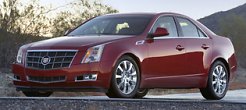 On the road, the new CTS with FE3 suspension package drives
like a German premium sedan and makes most Japanese competitors boring.
No matter grip, roll resistance, chassis balance, steering or
high-speed stability, it is right up to the level of German cars. This
is not a surprise, as the car was tested extensively in Nurburgring
Nordschleife during development phase. The only area it can't quite
match BMW 3-series and Mercedes C-class is agility. The CTS is as large
as a 5-series and weighs some 1830 kg (with manual gearbox) or 1860 kg
(with automatic). That's 300 kg heavier than 335i and C350 ! On the road, the new CTS with FE3 suspension package drives
like a German premium sedan and makes most Japanese competitors boring.
No matter grip, roll resistance, chassis balance, steering or
high-speed stability, it is right up to the level of German cars. This
is not a surprise, as the car was tested extensively in Nurburgring
Nordschleife during development phase. The only area it can't quite
match BMW 3-series and Mercedes C-class is agility. The CTS is as large
as a 5-series and weighs some 1830 kg (with manual gearbox) or 1860 kg
(with automatic). That's 300 kg heavier than 335i and C350 ! In the engine compartment, biggest news is a direct-injection version of the 3.6-liter DOHC VVT V6, which kicks out 304 horsepower and 273 lbft of torque while returning 3 percent lower consumption. It allows the Cadillac to compete on equal ground with Infiniti's and Lexus' V6. The next engine is the existing port-injected 3.6 unit with 263 hp and 252 lbft. For European, Chinese and Middle East market, the CTS is offered with a tax-friendly, 2.8-liter version of the V6 with 210 hp and 194 lbft. 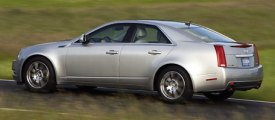 To
cope with the hefty kerb weight, our first choice is the 304hp direct
injection V6, of course. It is capable to sprint from 0-60 in 5.9
seconds, a whole second quicker than the old car. Nevertheless, such
improvement is partly due to a shorter final drive ratio chosen to
compensate for its extra weight. If we observe the time taken for 0-100
mph acceleration, we will find it is considerably slower than BMW 335i,
Infiniti G35 and Lexus IS350. Even the front-drive Lexus ES350 and
Toyota Avalon are quicker than the Caddy to the ton. Apart from
performance, we are not satisfied with the NVH level of the
Holden-based engine. It produces more vibration than other premium
six-cylinder engines and sounds quite coarse at the upper rev band. To
cope with the hefty kerb weight, our first choice is the 304hp direct
injection V6, of course. It is capable to sprint from 0-60 in 5.9
seconds, a whole second quicker than the old car. Nevertheless, such
improvement is partly due to a shorter final drive ratio chosen to
compensate for its extra weight. If we observe the time taken for 0-100
mph acceleration, we will find it is considerably slower than BMW 335i,
Infiniti G35 and Lexus IS350. Even the front-drive Lexus ES350 and
Toyota Avalon are quicker than the Caddy to the ton. Apart from
performance, we are not satisfied with the NVH level of the
Holden-based engine. It produces more vibration than other premium
six-cylinder engines and sounds quite coarse at the upper rev band. Caddy
offers two transmissions for the new CTS. The first one is an updated
Aisin 6-speed manual box. It claims to have improved shift linkage for
shorter gear throws, but on the road it can't match a BMW gearbox for
slickness. Fortunately, manual transmission is likely to account for
only a few percent of the production. The majority of buyers will
choose the new Hydra-Matic 6-speed automatic built by GM itself. Apart
from the lack of paddle shift, this transmission has everything a good
automatic ought to have: smooth in auto mode, responsive in sport mode,
throttle blip at downshift to match rev, hold a gear until near red
line during enthusiastic drive. Caddy
offers two transmissions for the new CTS. The first one is an updated
Aisin 6-speed manual box. It claims to have improved shift linkage for
shorter gear throws, but on the road it can't match a BMW gearbox for
slickness. Fortunately, manual transmission is likely to account for
only a few percent of the production. The majority of buyers will
choose the new Hydra-Matic 6-speed automatic built by GM itself. Apart
from the lack of paddle shift, this transmission has everything a good
automatic ought to have: smooth in auto mode, responsive in sport mode,
throttle blip at downshift to match rev, hold a gear until near red
line during enthusiastic drive. The new CTS does not set any new standards for compact premium class. It still needs to improve its engine and energy efficiency, but everything else is up to world standard. We are particularly impressed by its attention to interior quality and handling, the two areas at which European premium cars are so strong. Cadillac sold only 300,000 units of the first generation CTS. The new car deserves more success. |
| The above report was last updated on 3 Aug 2007. All Rights Reserved. |
CTS Coupe
|
||||||
Shortly after Cadillac CTS went into production, its coupe version was shown at Detroit motor show in the beginning of 2008. Although reaction to the aggressive-looking coupe was overwhelming, GM did not have money to realize it as itself was conserving cash to avoid bankruptcy. All new projects bar Volt were put on hold. Eventually, the emergency rescue plan fell through, and the American giant went into bankruptcy protection. The rest was history… The bankruptcy explains why it took two and a half years to produce what is deemed to be a straight forward conversion. Mechanically, the Coupe is almost identical to the sedan. Powering it is none other than the 3.6-liter direct-injected V6 with 304 horsepower (the sedan's entry-level 3.0-liter unit was skipped as it won't be big seller anyway). Transmission is the same 6-speed manual or 6-speed automatic, although a higher final drive ratio is chosen to improve acceleration. Wider tires, a 50mm stretch of rear track and slightly stiffer suspensions complete the mild mechanical revisions.
In fact, the biggest change is cosmetic. From A-pillars forward, the Coupe looks identical to the sedan. Thereafter it starts to differ - a steeply-raked windscreen, fast-angle rear window and C-pillars, 2 large doors and a roof set 50 mm lower than the sedan's. These make it look exceptionally aggressive. The shallow windows seem out of proportion to the muscular body, generating enormous tension. Some may regard it as ill-proportioned, but it does look bold and striking, something American designs need. Cadillac's Art & Science design theme is taken to higher level by the car's wedge shape and sharper tail design, with cutting-edge taillights and a diamond-shape brake light that doubles as a rear spoiler. Twin-centrally mounted exhaust differs it further apart from the sedan, no matter visually or aurally. Inside, environment up front is unchanged, although the front seats are mounted an inch lower. Of course, with shallow glass and a low roof, you feel the ambience less airy. Tall drivers may find headroom tight, so sunroof is best to be avoided. The back seat is designed for children or short adults as its headroom is reduced by 65 mm. That said, such compromises is just as expected on any coupes.
On the road, the big V6 produces enough power and torque to enable a brisk performance. 0-60 mph might be a couple of tenths quicker than the sedan due to the shorter gearing, but it doesn't feel night and day different. The Coupe is no lighter than the sedan, and its aerodynamic drag is actually slightly higher due to the wider rubbers and rear track. This mean those looking for BMW 335i or Infiniti G37 performance will be disappointed. Generally speaking, the handling is slightly sportier than the sedan. There is more grip and tighter body control. The optional Sport package with stiffer suspensions, 19-inch wheels, 245/45 front and 275/40 rear rubbers delivers even stronger roadholding, but it is suitable to very smooth roads only. For cost reason, the Coupe does not offer magnetorheological adaptive dampers like the high-performance CTS-V, otherwise the sport suspension would have been a great choice. With standard suspension and tires, the CTS Coupe is reasonably capable, but it won't challenge 3-series Coupe for driving fun. Still, it is an interesting addition to the CTS family which will also include a wagon soon. |
||||||
| The above report was last updated on 9 Jul 2010. All Rights Reserved. |
CTS-V Coupe
|
||||
Having known CTS-V and CTS Coupe, I guess you don't need more technical analysis on CTS-V Coupe, do you ? So let's concentrate on the outcome. There are many things to love CTS-V Coupe. Most obvious of all is performance. Powered by the same 556hp supercharged 6.2-liter push-rod V8 as the existing CTS-V sedan, this Detroit muscle can beat BMW M3 easily in whatever performance measurements. 0-60 mph is achievable in just over 4 seconds. 5 more seconds will crack the 100 mph mark. Top speed is an incredible 191 mph with manual transmission, or 175 mph with automatic. It is hard to imagine who would need more performance. Tremec's 6-speed manual gearbox has never been renowned for shift quality, so I suppose most buyers will opt for GM's Hydra-Matic 6-speed automatic. It makes the performance all the more appealing as it asks for so little effort from the driver. Yes, probably too effortless for keen drivers. This gearbox has manual mode, of course, but it does not add to driver involvement because 1) gearshift remains slow; and 2) the shift is implemented by two rocker switches located on the steering wheel, which is not as intuitive as paddles. The Hydra-Matic is neither as fast as new generation twin-clutch gearboxes nor as sweet as the ZF automatic on Jaguar XFR.
Gearshift aside, everything else looks positive. The stiff suspensions bring good body control yet the magnetorheological adaptive damping keeps an agreeable ride comfort. Grip from the monster-size Michelin Pilot Sport PS2 is beyond criticism. Ditto the huge Brembo brakes. You can push the CTS-V Coupe very hard into bends, using the gigantic torque to unsettle its rear tires and access its progressive power slide. The testing work carried out at Nurburgring ensures its handling to be nearly flawless. It won't bite you, just react to your wish with its deep reserve of talent. Hard to believe this car can belie its 1900+ kg weight so well. In the end, is it as good as M3 ? In terms of driver appeal, it runs very close to M3, and probably would have surpassed the latter had it got a better transmission. However, taking other factors into account, the Cadillac seems not to be as good a purchase. First of all, it is more expensive than the German car, even at its home market. Then you will find a number of areas less polished than the BMW, such as more wind and tire noise on motorway, which are down to its huge rubbers and angular shape. The big supercharged V8 is inevitably thirstier, especially with more weight to haul. Moreover, the Cadillac's rakish design leads to a cramped rear accommodation. That also leads to a question: isn't the CTS-V sedan a wiser buy ? With virtually the same performance and handling, the more practical sedan just might be the biggest rival to the new coupe ! |
||||
| The above report was last updated on 7 Aug 2010. All Rights Reserved. |
| Specifications | ||||||||||||||||||||||||||||||||||||||||||||||||||||||||||||||||||||||||||||||||||||||||||||||||||||||||||||||||||||||||||||||||||||||||||||||||||||||||||||||||||||||||||||||||||||
|
||||||||||||||||||||||||||||||||||||||||||||||||||||||||||||||||||||||||||||||||||||||||||||||||||||||||||||||||||||||||||||||||||||||||||||||||||||||||||||||||||||||||||||||||||||
| Performance tested by: *C&D, **MT, ***R&T, ****Autocar |
Copyright©
1997-2010
by Mark Wan @ AutoZine
